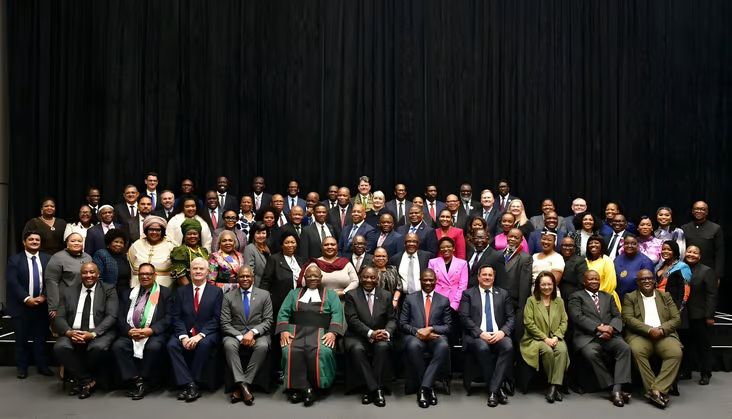
Cabinet Shuffle has reshaped the Government of National Unity with the removal of the Minister of Forestry, Fisheries and the Environment and the appointment of Willem Aucamp (DA). This is the first high-profile personnel change in the current GNU and it speaks to shifting coalition dynamics, policy priorities and accountability expectations. The swap comes as the DA seeks stronger performance from its ministers and as the presidency aims to maintain coalition balance. The change is political and practical: it affects conservation policy, climate diplomacy and oversight of natural resources at a critical moment for South Africa. (Sources: Reuters, local press statements.)
Cabinet Shuffle began when President Cyril Ramaphosa removed Dion George from his role as Minister of Forestry, Fisheries and the Environment and named Willem Aucamp of the Democratic Alliance as his replacement. The decision was implemented under constitutional powers to appoint and remove ministers. The DA had requested a reshuffle of some of its cabinet appointments, arguing for stronger leadership and better performance across departments. This action restored the DA’s ministerial representation to its original number within the coalition and signals more direct party involvement in cabinet management.
The Cabinet Shuffle underscores how sensitive coalition governments can be. In a Government of National Unity, parties must balance political goals with the need to demonstrate competence in government roles. The DA’s move to replace its minister reflects internal pressures to show results and to manage public perception. For President Ramaphosa, approving the change preserves coalition stability while responding to partner demands. The swap thus functions as a bargaining tool and a public demonstration that underperformance will be addressed.
With the Cabinet Shuffle, expectations shift for the Department of Forestry, Fisheries and the Environment (DFFE). The new minister faces immediate tasks: strengthening environmental governance, tackling regulatory backlogs, and coordinating climate policy ahead of international commitments. Stakeholders—environment groups, industry players and local communities—will watch for changes in regulatory tone and the handling of contentious issues such as land use, water allocation and coastal conservation. The new leadership could bring fresh priorities or recommit to existing plans; either way, operational shifts are likely.
South Africa’s DFFE plays a central role in international climate forums and in fulfilling commitments under agreements such as the Paris Accord. The Cabinet Shuffle therefore has diplomatic resonance. A new minister will be evaluated on readiness to engage credibly with international partners, to defend national positions at climate talks, and to implement climate finance deals. Continuity matters in global negotiations, so a swift and coherent handover is vital to avoid diplomatic friction and to sustain momentum on climate action.
Political stability and predictable governance are important for investors. The Cabinet Shuffle sends a mixed signal: on one hand, it shows a willingness to enforce performance standards; on the other, frequent reshuffles can raise concerns about policy consistency. Market actors will assess how the new minister handles environmental approvals, mining and fisheries regulation, and land-use policy—areas that directly affect sectors like mining and agriculture. The short-term reaction may be muted, but long-term investor confidence depends on clear, consistent policy direction after the shuffle.
From a governance perspective, the Cabinet Shuffle is an accountability test. Removing a minister for underperformance can reinforce public expectations of responsibility and transparency. However, critics will assess whether the change addresses root causes such as capacity constraints, political interference, or systemic problems. For the GNU to build lasting credibility, the shuffle must be accompanied by improvements in departmental performance, oversight mechanisms and meaningful engagement with civil society.
Any major swap brings risks. The new appointee must quickly build relationships with departmental officials, stakeholders and parliamentary committees. There is also a risk of policy discontinuity—projects may stall during transitions, and strategic initiatives may lose momentum. Political opponents could frame the shuffle as instability, and interest groups unhappy with the change may mount legal or public relations challenges. Managing these risks requires transparent processes, rapid briefing of the new minister and clear public communication.
After this Cabinet Shuffle, observers should track several indicators: statements by the new minister outlining priorities; speed of key appointments within the department; treatment of ongoing regulatory approvals; engagement at international climate events; and parliamentary oversight inquiries. How quickly the new minister addresses known bottlenecks will determine whether the shuffle delivers improved governance or becomes another headline without lasting impact.
Q1: Why did the President approve this Cabinet Shuffle?
The President approved the Cabinet Shuffle to respond to coalition requests, restore performance expectations, and maintain political stability within the GNU.
Q2: Will the Cabinet Shuffle change environmental policy immediately?
Policy changes may not be immediate, but the shuffle can shift priorities and the regulatory tone, influencing approvals and enforcement over time.
Q3: How does the Cabinet Shuffle affect international climate commitments?
It can affect continuity in negotiations; a quick, coherent handover is needed to maintain credibility in international forums.
The Cabinet Shuffle is more than a personnel change — it is a signal about coalition politics, governance standards, and South Africa’s approach to critical environmental and climate policy. While the appointment of Willem Aucamp restores DA representation and aims to boost performance, the new minister’s early choices will determine whether the shuffle delivers improved results, sustained investor confidence and stronger public trust in the GNU. Close monitoring, clear communication and rapid action on priority issues will be essential for the shuffle to produce meaningful outcomes.